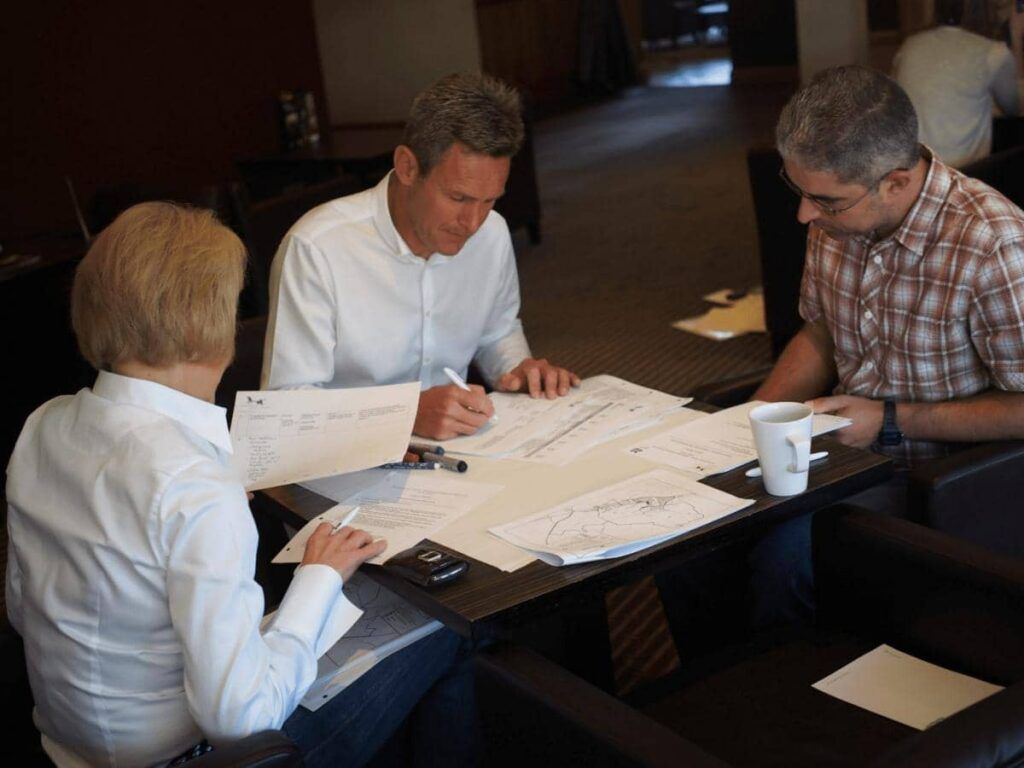One of the most difficult challenges in project management is setting realistic project exceptions so here we look at strategies that can help. Whether you are a novice project manager or you have years of experience, the last thing you want to do is under promise to the point where you cause disappointment. On the other hand, if you over promise you are going to set your team up for failure from the very start. That’s why it is so important to set realistic project expectations. To do this, you need to get involved during the planning process, identify potential pain points, and be honest throughout.
Table Of Contents
- Get involved during the planning process
- Have a clear project scope when starting out
- Set up calendar reminders for milestones
- Identify potential pain points
- Encourage communication between team members
- Make sure to incorporate other projects you are working on
- Don’t be afraid to communicate bad news and adjust expectations
- Track project metrics
- Have an escalation strategy
- Involve all stakeholders
- Ensure everyone understands his or her responsibilities and roles
- Track the project with a project management system
- Take a training course
- Don’t sugar coat it
- Hold regular status meetings
Get involved during the planning process
One of the biggest problems is that senior management tend to set deadlines for projects. This means that deadlines are put in place without any consideration for whether they can actually be met. This leads to deadlines that are established based on when management would like something to be finished, rather than when a project can be finished. This is why it is important to get involved from the very beginning of the planning process. You can then work with the senior management to put together key measurable objectives that both sides agree on. It certainly makes a massive difference to go about it this way because you will know more about the goals of the project and what senior management are expecting, and then you will be better placed to guide your team to success.
Have a clear project scope when starting out
When starting a project, it is essential to have a very clear scope. This is pivotal because people are always going to try to add to the scope, which can be one of the key factors in project failure. Scope creep always tends to stem from minor changes, which seem inconsequential at the time, but end up accumulating into a big issue. The best way to manage scope creep and, hopefully, avoid it altogether is to identify and address potential risks and mitigation actions. You must then rigorously evaluate any changes to the baseline plan, especially in regards to their impact on cost and schedule. It does not matter how insignificant you think these changes are; you need to assess their impact.
Do you understand...
What causes project failure?
Set up calendar reminders for milestones
It is a good idea to set up calendar notifications so that you can keep team members and projects on track. These notifications will alert your team members to when they need to complete certain steps and various due dates. This will ensure that your team members all have their minds in the right place and on the correct stage of the project.
Identify potential pain points
With every project, there are so many variables that are going to be going on. Plus, no matter how hard you prepare, there are always going to be aspects that are unknown. However, it can really help if you identify points in the development cycle where there could be potential surprises or risks involved. By being prepared, you will be in a position to respond better to these instances. This will not only ensure you keep projects closer to schedule, but you will have a much better relationship with the client too.

Encourage communication between team members
One factor that can kill your team, deadlines, and project is unstated assumptions. This is why it is important to put a communication plan in place. This is a plan that should err on the side of over-communication rather than under-communication. What should this plan include? In most cases, it will outline the scope of work, as well as who is responsible for each task, when a task is due, and the status update of the task. By sharing this information with all, it will enable your team to work better together.
The benefits of...
Project Management Training
Make sure to incorporate other projects you are working on
One of the biggest mistakes made when it comes to project estimates and project expectations is determining your estimates by only considering the one project in question. You accurately determine the effort and time that is required to develop and deliver the project in question. However, you have failed to consider the fact that the team may have other projects on the go at the same time. Therefore, resources may not be accessible for the whole project. This can lead you to cram in 80 hours of work into a 40-hour week, which will inevitably lead to delays even if you have a golden project team. Even worse, you will probably end up with a de-motivated team.
Don’t be afraid to communicate bad news and adjust expectations
If something has happened that will have a negative impact on the deadline of your project, the worst thing you can do is keep it a secret. You need to let all stakeholders know as soon as possible. Communicate issues in a concise and clear manner, getting to the point quickly and indicate how these issues will affect project expectations. After all, all projects are going to have roadblocks – nothing ever runs smoothly. The key is to be as honest as possible and disclose problems quickly. You will find that management will appreciate being brought up to date sooner rather than later, and it also gives you leverage to solve the issue as efficiently as possible.

Track project metrics
You need to define vital development metrics. After all, how are you supposed to set realistic project expectations for costs and delivery times if you do not have any data to base it on? Project metrics are great because they provide a basis for you and your team. You can go back and assess the performance of previous projects. This will help you to see the time that was taken for similar project features so that you can have a more realistic understanding of what will be needed this time around, helping you to bring project expectations to reality. If you don’t compare data, your estimates are going to be more guesstimates, and that is certainly not the way to go about your projects.
Have an escalation strategy
You need to keep project expectations in check because nothing ever goes to plan. If you talk to any project manager, they will tell you about all of the times that projects have diverted off track or something unexpected has cropped up. In fact, it will be extremely difficult to find any example of a project that has gone exactly as anticipated in the planning stage. This is why it is a good idea to have an escalation strategy in place. To develop clear guidance on what should be escalated, you should work alongside management. You also need to make clear what does not need escalating, as not everything will. Once you have done this, you can then discuss your guidance with your team. It is important to make sure they are all aware of how to escalate and what should be escalated. This will give your team the responsibility and accountability to sort things at their level when they are able to do so.
Involve all stakeholders
You need to get everyone’s input on project expectations and timelines. When we say everyone, we don’t mean every single person that is going to be working on the project – we mean all of the stakeholders. Let’s take IT projects as a prime example. You will want to get all of the IT professionals involved, from the junior programmer to the CIO. After all, the guys installing a new server or writing the code understand the project more than anyone else will. Their input is incredibly important.
The benefits of...
Project Management Training
Ensure everyone understands his or her responsibilities and roles
From the very beginning, you need to set realistic project expectations regarding what is expected of everyone, including senior management. Be clear about their jobs and roles for the project. Each team member should have a very clear understanding regarding how he or she fits into the project’s overall success. They need to know how many aspects tie together so that they know what they are working towards. You need to be clear about the activity and time commitment you expect from all executives and all team members. Don’t underestimate just how important this is with regards to executives. They often fill up their calendars weeks in advance, which is why you need to be clear about what you expect of them. A good understanding of KPIs, timelines, and goals should be shared by all.

Track the project with a project management system
Project expectations are rarely set in stone. They often change throughout the course of the project lifecycle. This is why it is a good idea to use a project management system to ensure that all stakeholders stay on the same page. There are many tools that can be used to track projects on a weekly basis, such as burn-down graphs. This will create the basis for fine-tuned adjustments to be made to the development cycle.
Take a training course
If you find that you are really struggling to set expectations and manage them, no matter how hard you try, you should take one of the project management training courses that are available. The key to being a successful project manager is to never stop learning. There are always new trends, techniques, and methods to learn, and a mere refresher can do you the world of good.
Don’t sugar coat it
It can be extremely tempting to tell a client what they want to hear. This is especially the case if it is a project for a new client. You don’t want to risk disappointing them and losing their business, and so you exaggerate slightly to keep them on side. This is the last thing you should do. It may make the client happy in the short-term, but it is only going to disappoint them in the long run. If you sugar coat estimates, the only thing you are doing is setting up your team for failure. Instead, you need to provide the hard facts. If the client is not satisfied, you can present alternatives on different ways to mitigate budget overruns or delays. Your client may be slightly disappointed, but you will ensure a better working relationship, and they will be happy at the end of the project, which is what really matters.
Hold regular status meetings
Last but not least, it is important to have regular meetings to discuss the status of the project. You should also set up reminders to make certain that everyone attends. From face-to-face meetings to conference calls, there are many different ways you can hold meetings today, and so it should not be a problem to get everyone together – even if you have a team that features a lot of remote workers. However, holding a meeting is not simply enough; you need to ensure it is a productive one. This includes being inclusive, honest, and open. The best approach is for all concerned parties to communicate directly. This enables you to communicate about the status of the project, address any issues or roadblocks, and work as a team to bring the project forward in the best manner.
All in all, as a project manager one of the most important things you need to do is manage expectations because this can make or break your project. To ensure you manage and set expectations effectively, use the tips mentioned above and you won’t go too far wrong. It is important that you get involved from the offset so that you can ensure expectations are realistic and you can guide your team in the best manner. Once you have done that, set up a project management system, as well as notifications for all team members, communicate honestly, and schedule regular status meetings.
You might also be interested in…

wow, thank you so much for highlighting the importance of clearly setting project expectations and having everyone agree on them. These tips will really help in my future projects.
It’s so important to communicate clearly and often about any issues that will impact what stakeholders can expect from a project – as you rightly say. But it’s very common for those same stakeholders to ignore what you are saying – often due to optimism bias. An unrealistic deadline has been set, for example, and stakeholders don’t want to hear that it is unacheivable. That’s why a project manager has to repeat their expert opinion again and again and again until it starts to be heard by stakeholders. Unfortunately this can make the PM unpopular or make them subject to accusations of negativity. So it’s also important to clealry distinguish between realism and negativity!
So true Chris! I think most project managers have been in the situation where stakeholders don’t want to hear about unrealistic timeframes, but it is possible to gradually influence the stakeholders so they come to understand the reality over time – sometimes at least. Take a look at our guides The Definitive Guide to Stakeholders and The Essential Guide to Negotiation Skills for Project Managers